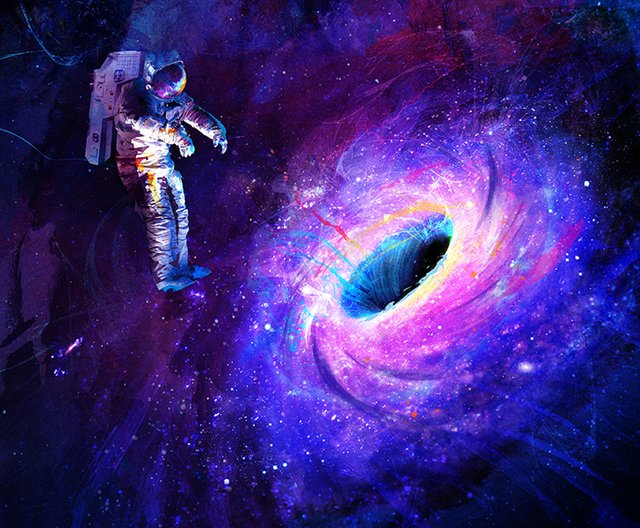The black hole phenomenon, even giant suns are sucked into these vast whirlpools in space

Beyond the earth's atmosphere lies an infinity of space that man has only just begun to explore. Its secrets are being tapped, one by one. Yet with every discovery made comes a new and often greater mystery. One of the most baffling that scientist has ever faced is the phenomenon known as black holes.
They cannot be seen, and the only evidence that they exists is the effect they have on other objects. They are like whirlpools in space. Any debris plunging it's way through space that may stray to near to a black hole is sucked into it's maw. Where it goes, scientists can only guess. What happens to it no one knows. Atomic particles, galactic dust, even giant suns can disappear without a trace. Do they cease to exist? Or do they travel in some strange fashion through time and space to another dimension?
Scientists do not have the answers. American physicist John Wheeler calls black holes 'the greatest crisis ever faced by physics'.
Black holes are giant stars which have suddenly collapsed inwards. According to one theory, the process is infinite. It goes on and on, with the star getting smaller and smaller and more dense. A star ten times bigger than the sun would end up as a black hole only 40 miles across.
A spoonful of this matter would weigh millions of ton's.
Because the gravitational pull of this relatively small, the dense object is so great, nothing, not even light, can escape from it. And all the normal scientific would not apply.
The first black hole was identified on 16 May 1973. Scientists were already investigating 'dead' stars. These include the so called white dwarfs - which our own sun will become when it cools down in about 8 million years. Larger stars die in a different way and become what is known as neutron stars. Others are called pulsars because of there regular signals they emit. But, scientists asked, what happens to the biggest stars of all?
The key to the mystery came from the constellation Cygnus, The Swan. A super-giant star in this constellation was behaving in an odd way. Further investigation showed that the star was being effected by the gravitational pull of an invisible neighbor. Although it could not be seen, all the evidence pointed to it's powerful existence. Then some intense study by three English scientists - Peter Sanford, Fred Hawkins and Keith Mason - provided proof that this invisible force was what was termed a black hole. Similar investigations were launched to prove the existence of another black hole in the Speculation Aurigae star system.
Study of the super-giant in The Swan constellation has shown that great clouds of gas are being drawn from the star into the black hole. As the star approaches the 'event horizon' - the point of no return after which it cannot be seen - the gravitational pull of the star and the black hole conflict.
Light emitted from this region travels so slowly that it seems almost to stand still.
In theory, if a man entered a black hole he would be stretched out, the part nearest the hole being attracted more quickly than the part furthest away. His image would linger for millions of years, even though his fall into a black hole would take only a fraction of a second. The tremendous force of gravity would finally break him down into atoms. But, by this point, time and space would have lost their conventional meanings. He would have entered what scientists call a singularity - the point where an infinity small object has infinite density and gravity.
Some scientists have asked what would happen if a man could avoid destruction on entering a black hole. One answer they came up with is that, because black holes defy all normal physical laws, when he emerged on the other side, he would find himself in a different universe - or even traveling backwards through time.
Another theory holds that man could eventually tap unlimited resources of energy from black holes by dumping rubbish into them and trapping and storing the gravitational energy that would be produced. There is one snag to this, though. If the greatest care were not taken, the black hole could grow large enough to suck the earth - and eventually the whole universe - into oblivion.
Black holes may help solve another great mystery - what holds the universe together? According to the 'big bang' theory, the universe was created by a gigantic explosion and is constantly expanding. But in that case, what is stopping the universe from flying apart infinitely? The great scientist Albert Einstein suggested that there must be enough mass in the universe to hold it together. This mass could be black holes, countering the effects of the 'big bang' and drawing other stars and there planets towards them. If this is so, the the process would over millions of years speed up, the black holes eventually consuming every heavenly body. And , instead of ending with either a bang or a whimper, the universe would simply be swallowed up!
I hope you enjoyed the read, please follow me @bitminter for my next post on another fascinating subject.
Cheers
In theory if the black holes are attracting and consuming all mass in the universe then they would attract each other as well, so what would happen when two black holes come across each other?
Then lets say theoretically the largest black hole consumes all other black holes and then? This is definitely food for thought, thanks for sharing.
This kind of thing absolutely fascinates me simply because like you say 'food for though'. Thanks for the comment.
No problem enjoyed the read!
Awesome pic, Thanks for the interesting post I am now following.